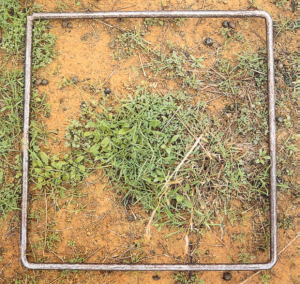What is the fundamental key for successfully keeping horses, producing beef or pasturing poultry, pigs or small ruminants? It is the quality of grass you are raising.
If you have a trust fund, you can feed expensive hay. The rest of us depend on grass. Perceptive livestock producers understand they are “grass farmers,” first and foremost. Cattle, goats, and sheep are the vehicle through which they market their grass.
As we approach the heavy grazing season, then, it is time to assess and improve.
Steps to prepare for prime grazing season
-
- Soil test. We have the bags and instructions. Please contact me about soil sampling. You can’t improve what you don’t measure. You don’t want to apply expensive lime and fertilizer if you don’t need it… unless your trust fund is fully funded. Even so, excess nutrients end up in our waterways, and that does not end well.
- Evaluate your grass stand. If you have 75% or more of a palatable well-adapted warm-season grass, then you are set and probably just need fertilizer (see item 1, above.)
- Evaluate weed pressure. Identify weeds and determine elimination strategy. Use integrated pest management (IPM). Determine if mechanical, biological, organic or chemical solutions are necessary. Join us July 17 for our “Raising Forage for Cattle and Horses on Ranchettes” webinar to learn IPM strategies and more.
![pasture weed identification chart. [credit: uf/ifas extension]](data:image/gif;base64,R0lGODlhAQABAAAAACH5BAEKAAEALAAAAAABAAEAAAICTAEAOw==)
- Go back to soil test (item 1). Determine if you need to adjust pH (generally, by adding lime in our soils) to the optimum level for your forage to thrive. After lime application, determine needs for nitrogen, phosphorus, potassium or micronutrients. Apply at beginning of rainy season in split applications to make sure it is utilized. Pay attention to municipal ordinances for fertilizer applications.
- Put the right number of animals to match the amount of forage you are raising. Too many animals and they hurt the health of your grass and your pocketbook. If you have too few animals, then your grass may go rank and not be palatable.
- Put up some cross-fencing to give your grass more rest to regrow above and below ground. Like kids, if you put chocolate and broccoli on a plate, they will eat the chocolate first and go back to it again until it is gone. Cattle and horses do the same. They will go to the best grass and eat it down to the ground. Soon, it doesn’t regrow, and then you need to again check item 2 (above). You need 28 days or more of rest to keep your grass healthy. The best weed control (see 3, above) is fast-growing grass to outcompete the undesirable weeds.

If your stand looks like this (less than 40 percent coverage), you likely need to renovate. - If grass stand is below 50% or weeds dominate the stand, you might need to start over. You will need to kill existing stand and create seedbed for new seeds or sprigs. If you don’t have equipment, contact our office for recommendations for contractors. You want to reseed during rainy season to have adequate moisture for establishment. Check out this publication for best practices for Bahiagrass renovation and fertilization.
Your most important input
The most important thing you can put on your pasture is your foot. Lots of footprints mean you are scouting, observing and measuring. The sooner you assess the shortfalls of your pasture, the sooner (and more cheaply) you can get it growing productively again. Then, you can refocus on your livestock. But never take your foot off….your pasture.
 4
4
![Soil testing sample bag from the UF/IFAS Extension laboratory system. [credit: uf/ifas]](https://blogs.ifas.ufl.edu/sarasotaco/files/2024/05/2024_Ag_bagSoilTestExtensionLabTINY-225x300.jpg)
![pasture weed identification chart. [credit: uf/ifas extension]](https://blogs.ifas.ufl.edu/sarasotaco/files/2024/05/Pasture-Weeds-300x241.jpg)

